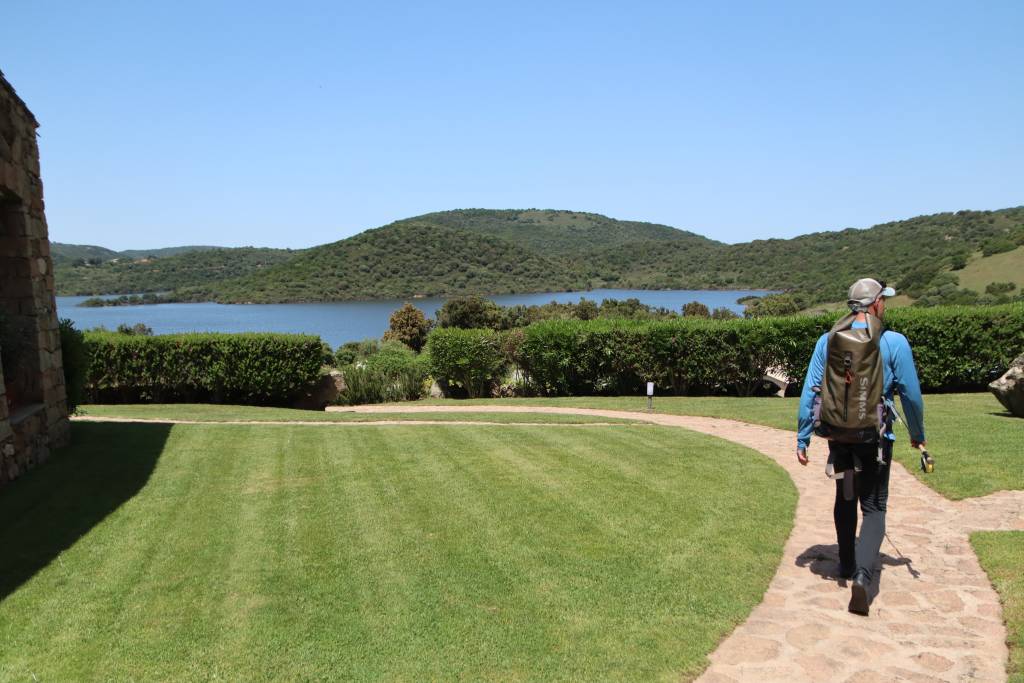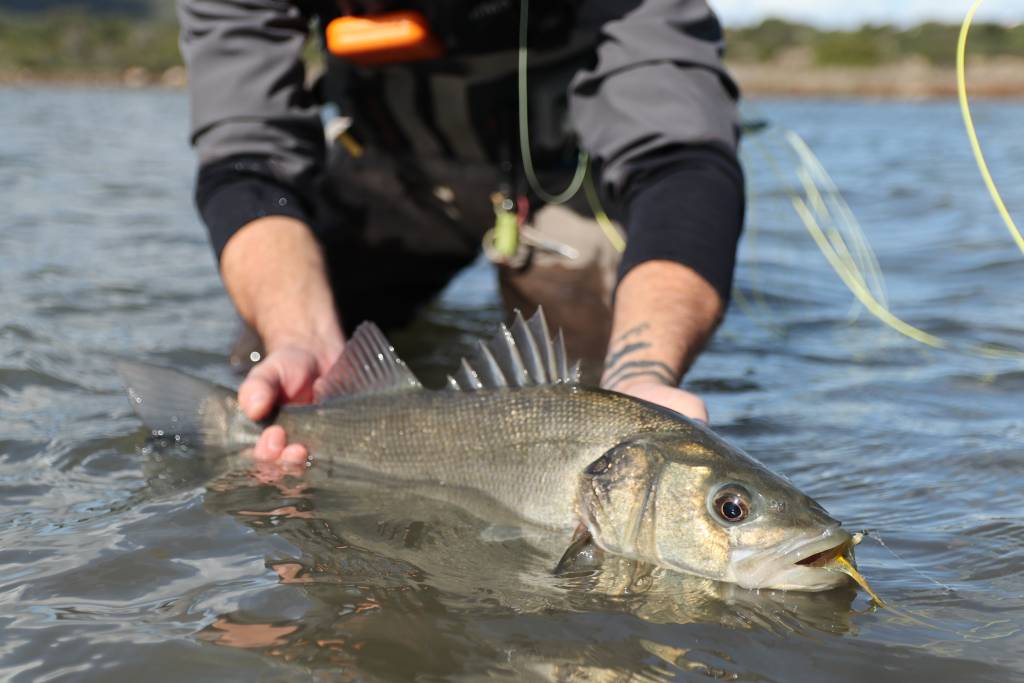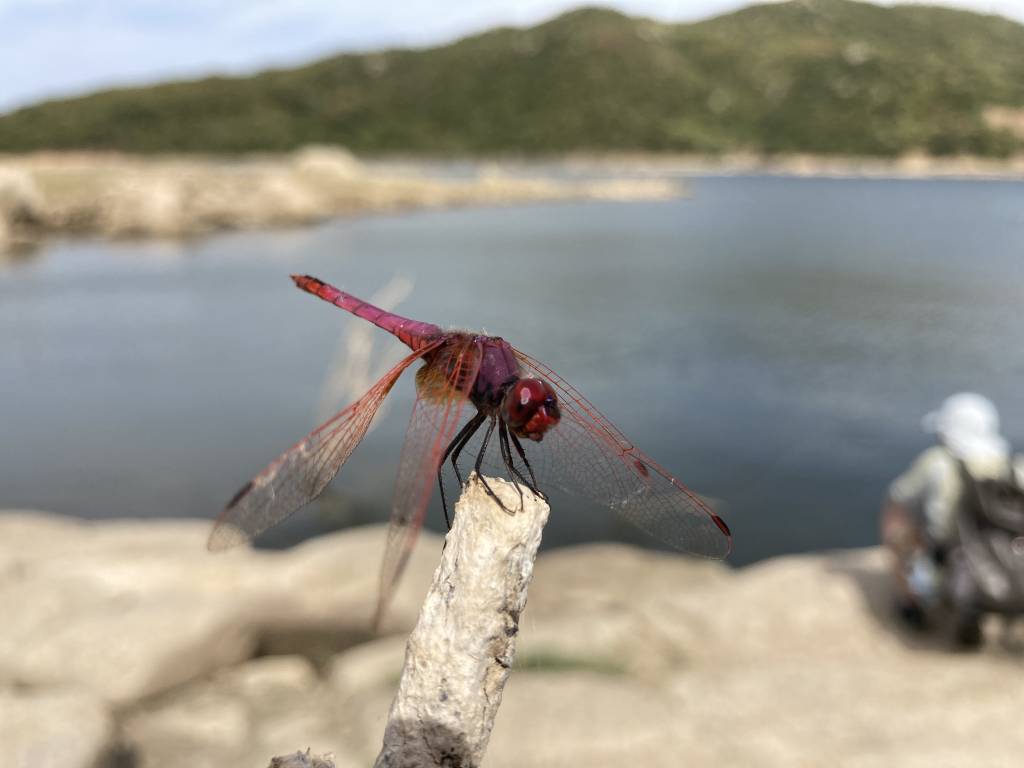Sardinia is a rather remote Italian island in the middle of the Tyrrhenian Sea. Not many fly fishermen know about Sardinia and the fish species encountered there, but with fishing possibilities both inland and offshore – and loads to do and see – it’s a destination that ought to be on more people’s bucket lists.
BY OMAR GADE
PHOTOS BY: Omar Gade and sardiniabassfishing.com

Certain areas have a special place in our hearts and in our memories. Whether it’s because of people we have met, emotions we have buzzed with, landscapes we have emersed ourselves in, culture and history we have acquainted ourselves with, or memorable activities that we’ve engaged in – an invisible bond is created when we visit places that truly impress us.
For me, one of these places is Sardinia, but not simply because of the fishing (which we’ll get to in due time). During my childhood, in Italy, I made friends with some school classmates from Sardinia. In my imagination, as a child, they came from a remote tropical island full of wonder, and the whole place was just fascinating to me. I remember my Sunday lunches, when I was hosted by their parents and rigorously ate Sardinian specialties, such as “carasau bread” and exquisite hand-made “malloreddus” sprinkled with very tasty sheep cheese.
A long-lasting love story
My first visit to Sardinia dates back to the year 1992, and since then I have visited Sardinia almost every year – often several times a year. Along the way, I have discovered many uniquely beautiful places that I’ve grown gradually fonder of. But I’m not alone in my fascination with Sardinia. The island, a rare pearl, is the favourite destination of lots of visitors who, during the summer months, crowd the beaches and coves and submerge themselves in the crystalline waters. In my opinion, the Sardinian beaches are the most beautiful in the Mediterranean Sea, and – surely – some of the nicest in the world.
But how did tourism developments come about on this island? In its millenary history the Sardinian population, which was composed mostly of shepherds and farmers, never showed much interest in its coastal shores. They must have taken them for granted, not seeing any development possibilities in terms of business. The beaches provided little economic value until the 1960s, and even by then, they only provided only a minimal contribution to the local economy compared to the inland pastures and cultivated acreages.

A Sardinian friend from Olbia told me once: “Coastal areas were often bequeathed to women, because the coast and the beaches were considered not interesting… but due to the economic boom, a good
number of women, who had been economically dependent on the men of the family till that moment, suddenly realized they sat on a treasure! There were some golden marriages from then on…”
The development of tourism
Sardinia, as we know it today – as a tourism destination, is the result of policies adopted in the early 1950s and the role that rich dreamers have played since the 1960s, first and foremost, the Arab prince Kerim Āghā Khān, who at the time was just over twenty years old. He is considered one of the founding fathers of the “Costa Smeralda” that we all know today. However, in addition to the sea, which is as beautiful as in the Caribbeans, and the fantastic tourism facilities now present, there is much more to discover in Sardinia. To begin with, more than 25% of Sardinia is designated as parkland and wildlife reserves.
“It’s one of the most exciting and adrenaline-soaked fishing situations that exists”
The island has a strong cultural identity, which is fascinating and sometimes mystical. Its history traces back to ancient times, something that’s substantiated by numerous archaeological sites, ruins of old towns, nuragic complexes, necropolises. (Sardinia has more than 7000 ancient sites that date from before 1000 BC).



Sardinia benefits from a vast uncontaminated hinterland, which has been capitalized on by the international motion picture industry. Film crews in search of unique film sets have been drawn to Sardinia for decades, and Sardinia has featured in many film productions: from western films to science fiction – and James Bond films. Moreover, the healthy terrain and soil, the sun, and the Mediterranean climate, together with genuine culinary traditions, have ensured Sardinia a central position in Italy when it comes to eno-gastronomic specialties.
The fishing
“And do you fish too?”, you will be wondering by now… Of course! On such an island with crystal-clear waters, it is obvious that the saltwater fishing is great. In fact, Sardinia offers a great variety of opportunities when it comes to sea fishing (from a boat).
The uniqueness of this destination is that it gives you the opportunity to combine a perfect holiday with your fiancée or family and your passion for fly fishing. Highly reputed charter boats are available at the marina of Porto Rotondo, which is also the European location chosen by the I.G.F.A for some of their European fishing events.
In saltwater, the locals practice the same fishing that’s common across the whole of the Mediterranean Sea: deep-sea fishing, trolling, and vertical jigging. Among the most frequent species that can be caught are; tuna, other pelagic sgombrids, dentex, groupers, swordfish, snapper, amberjacks, leerfish, and dorado (mahi mahi).

Lots of possibilities for the fly fisherman
On a good day, as in other areas of the Mediterranean Sea, fly fishermen can be lucky enough to come across hectic surface activity, so-called “mangianze” in the local language. Seeing a feeding frenzy of tunas or, other minor sgombrids such as false albacore and bonitos, at a few meters’ distance, and casting your fly into the chaos, is just insane. Personally, I find this one of the most exciting and adrenaline-soaked fishing situations that exists. Situations like this don’t happen all the time, and – compared to other regions of Italy, it is even rarer in Sardinia – but when it happens right in front of your boat… Wow, it’s just crazy!
Boat fishing is fun, but shore fishing and wading is certainly more suitable for fly fishing here. Sardinia has more than 1800 kilometres of coastline, and there are lots of sheltered lagoons. Many lagoons offer great fishing for seabass, but it is a quality- and not a quantity type of fishing experience. The flies to be used are the classical ones for this species; imitations of shrimp, baitfish, Clouser Minnows, and the likes.




Seabass in the lagoons
In the lagoons, I usually fish, the seabass are often tailing in knee-deep water, and a little crab imitation is often the right choice. It’s just like fishing the exotic flats in the Caribbean or the Seychelles. When not tailing, seabass can be targeted with topwater flies like poppers – flies that generate a lot of noise and splashes on the surface. And when the seabass decide to zone in for the kill, they take the flies with extreme aggression.
“The Sardinian beaches are the most beautiful in the Mediterranean Sea”
The success of the seabass fishing depends a lot on the tides – and especially the periods after the changing tides can provide good fishing. In the lagoons, seabass typically co-exist with seabream and very big mullet. The latter are almost impossible to catch as they feed almost exclusively by filtering the water and sand for micro particles and nutrients. However, if you see big schools of seabream or mullet, the seabass are usually not too far away.

Black bass
For me, the best fishing in Sardinia is inland. And the preferred target species is black bass – or largemouth bass as they call them in the US. The inland waters – the most “wild territories” of the island – are populated by black bass, a widespread species in the lakes of Sardinia. The species was imported to the island in the 19th century from America and is now the main predator species in Sardinian inland waters.
“Black bass are aggressive fish, capable of spectacular jumps and fights”
Black bass are known and appreciated by lots of Italian spin fishermen, and some lakes are rather frequented with considerable fishing pressure as a result. However, as with the rest of the world, the rule of thumb, that the best waters are the least disturbed ones, is valid here too. (Having said that, in Sardinia it is very important to pay attention to unmarked prohibitions, private access restrictions, and general regulations and restrictions. Not all lakes are open to fishing, and there’s no point in getting into trouble with the locals).
In Europe, black bass is not one of those species typically associated with fly fishing. In my opinion, this is a big mistake. It is an aggressive fish, capable of spectacular jumps and fights, and it’s a cool, challenging, and fun predator to catch on the fly rod! They look amazing too! The Sardinian black bass have wonderful colourations with marked green/black contrasts, and they reach remarkable sizes.
Fishing is mostly practiced in medium-sized and big lakes with fairly deep water, and in reservoirs with good water clarity. In the warm summer season, some of the big reservoirs will diminish and grow increasingly shallow due to the increases in water withdrawal.
Flies that disappear
It is possible to effectively fly fish black bass in certain areas of the lakes; at a depth of 0 to 5 meters. The best conditions are found during the warm season, especially when it comes to topwater flies: frogs, poppers, divers, and dragonfly imitations. The black bass here, when chased on the surface, have two ways of taking the fly: The classical “surface attack” with big, noisy splashes or a silent, almost imperceptible “vacuuming up” of the fly, where the bass sucks the fly into its big mouth from below the surface. In the latter case your fly will simply vanish from the surface with very little commotion – just disappear. It’s quite a cool thing to experience!
Effective flies for black bass are: Wolly Buggers, Clouser Minnows, Dahlberg Divers, Muddler Minnows, Bunny Leeches, Gurglers, Poppers, surface frog imitations, foam hoppers, crawfish patterns etc. Good fishing is often concentrated in small bays and along the banks, among submerged
trees and branches where the big bass wait in ambush for their prey. Fishing in these snaggy micro-habitats, surrounded by an old “Western movie” atmosphere in the heat of the very hot Mediterranean sun, is special in- and of itself – and at times a surreal reality.



Want to catch black bass in Sardinia?
If you want to try this fascinating experience, I suggest that you check out Sardinia Bass Fishing. They are the only specialized operator for fly fishing trips in Sardinia (fly fishing is almost unknown in Sardinia) – and they are ready to provide the best possible service. They can also help you personalize your Sardinian holiday- and fishing experience whether you’re looking for a full-time fishing holiday or just a single day fishing trip ad-on. Check out: www.sardiniabassfishing.com













